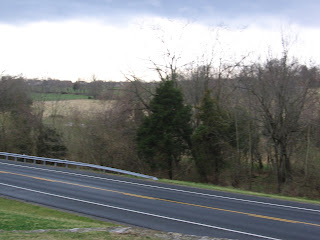The Mary Grove Locher Cabin on the Alfred Poffenberger farmstead is at the heart of the West Woods experience. It lies just west of the original woods, now marked by the 15th Massachusetts Monument, and just across the busy highway bypass. The cabin is one of the oldest structures in Washington County and dates back to the 1780s. In September 1862, it was "used as a Confederate infirmary prior to the Battle of Antietam, a temporary medical aid at the time of the battle, and a Federal encampment for a month after the cessation of fighting." (Antietam National Battlefield, Mary Locher Cabin, Analysis of Finishes, Feb. 4, 2000, n.p.).
The first official mention of the cabin comes in 1792. The Historic Structures Report notes that in that year the "'Resurvey of Addition to Piles Delight' [shows] the property of Mary Locher Cabin was up for sale--[and the] advertisement states that land is under cultivation by renters or leasees." (Historic Structures Report: Physical History and Condition Assessment of Mary Locher Cabin, Antietam National Battlefield, Sharpsburg, Maryland, page 13). In 1840, the last will and testament of Philip Grove divided the property into two parcels. The east parcel went to his eldest daughter Mary Grove Locher--who resided in Lancaster County, Pennsylvania. The will listed standing structures--the cabin, root cellar and barn. (Ibid, p. 23.).
During Mary Grove Locher's ownership, the farmstead was leased to Alfred Poffenberger who acted as a resident tenant farmer. As reported here in an earlier post, the 1860 census shows Alfred Poffenberger, then 26, resided in the cabin along with his 22 year old wife Harriett, and one-year-old William. Also there were Emma Ziah, a 10 year old, and Peter Krutzer, who is listed as a 28 year old "farm hand." Poffenberger listed the value of his real estate at $3,000 and personal property at $500.
This leads to a curious part of the Poffenberger / Locher Cabin narrative. The Historic Structures Report contains a chart on page 25 showing the Poffenberger Family history "from published family information: A History of Washington County, Maryland (Volume II) by J.C. Williams." The chart states, that "As a young man of 28 years, he [Alfred Poffenberger] may have fought in the rebellion because the farmhouse was reportedly abandoned at the time of battle. 1860 Census records report 2 children, a young male slave and a male farmhand assisted Alfred on the farmstead." Below is the 1860 Federal Census record for the Alfred Poffenberger household. Only four individuals are listed in the household. While he may have used a male slave and a male farmhand, there is no record of it in the Census of 1860 and slaves and farmhands were enumerated in the 1860 Census.
 The statement that Alfred Poffenberger may have "fought in the rebellion because the farmhouse was reportedly abandoned at the time of the battle" is also curious. First one statement, does not support the other. That the farmhouse was abandoned "at the time of the battle" does not necessarily mean that it was abandoned at a time prior to the battle or at a time after the battle. Second, most farmhouses "at the time of the battle" were abandoned -- and for very good reasons.
The statement that Alfred Poffenberger may have "fought in the rebellion because the farmhouse was reportedly abandoned at the time of the battle" is also curious. First one statement, does not support the other. That the farmhouse was abandoned "at the time of the battle" does not necessarily mean that it was abandoned at a time prior to the battle or at a time after the battle. Second, most farmhouses "at the time of the battle" were abandoned -- and for very good reasons.Did Alfred fight in the War? A quick look at Maryland Soldiers in the Civil War (Vol. 1) turns up two Poffenbergers--Elias and Henry--but no Alfred.

























